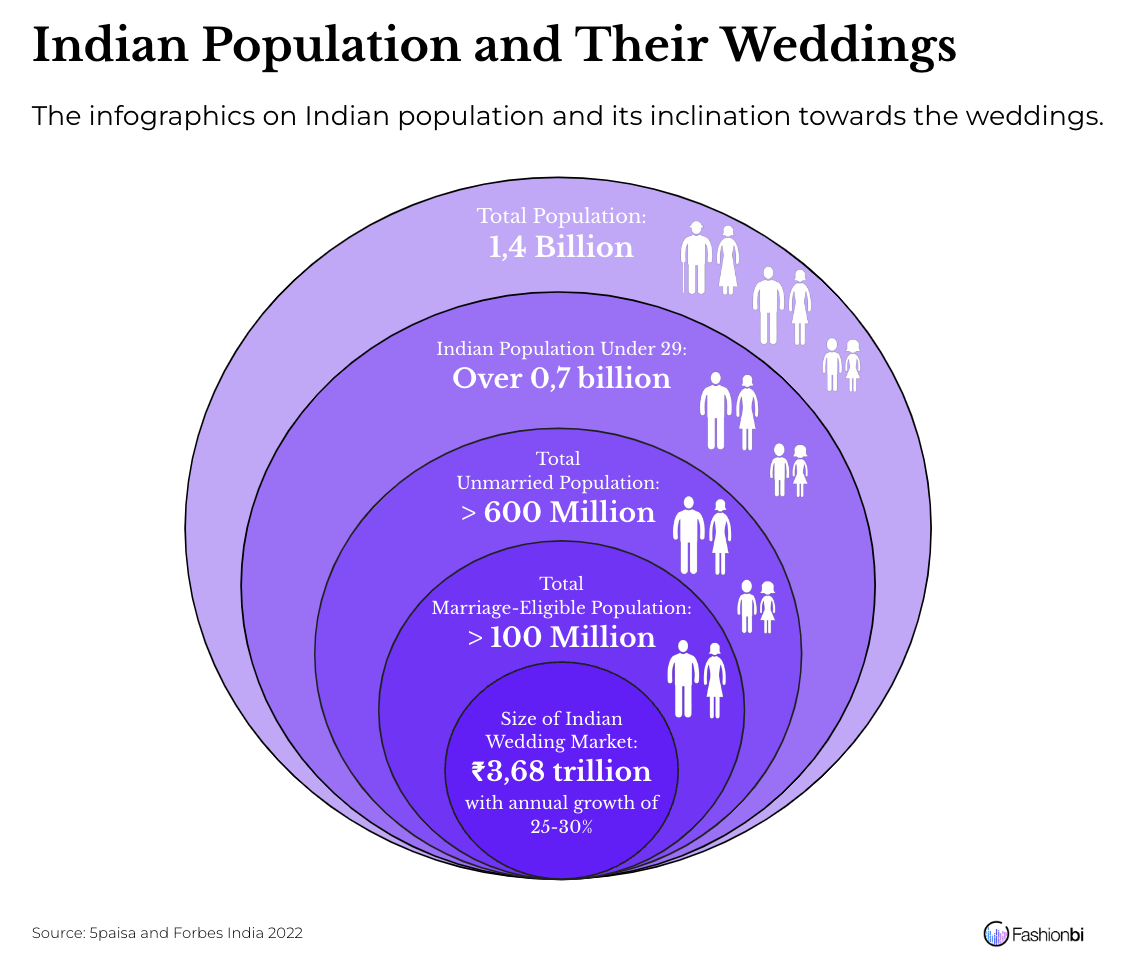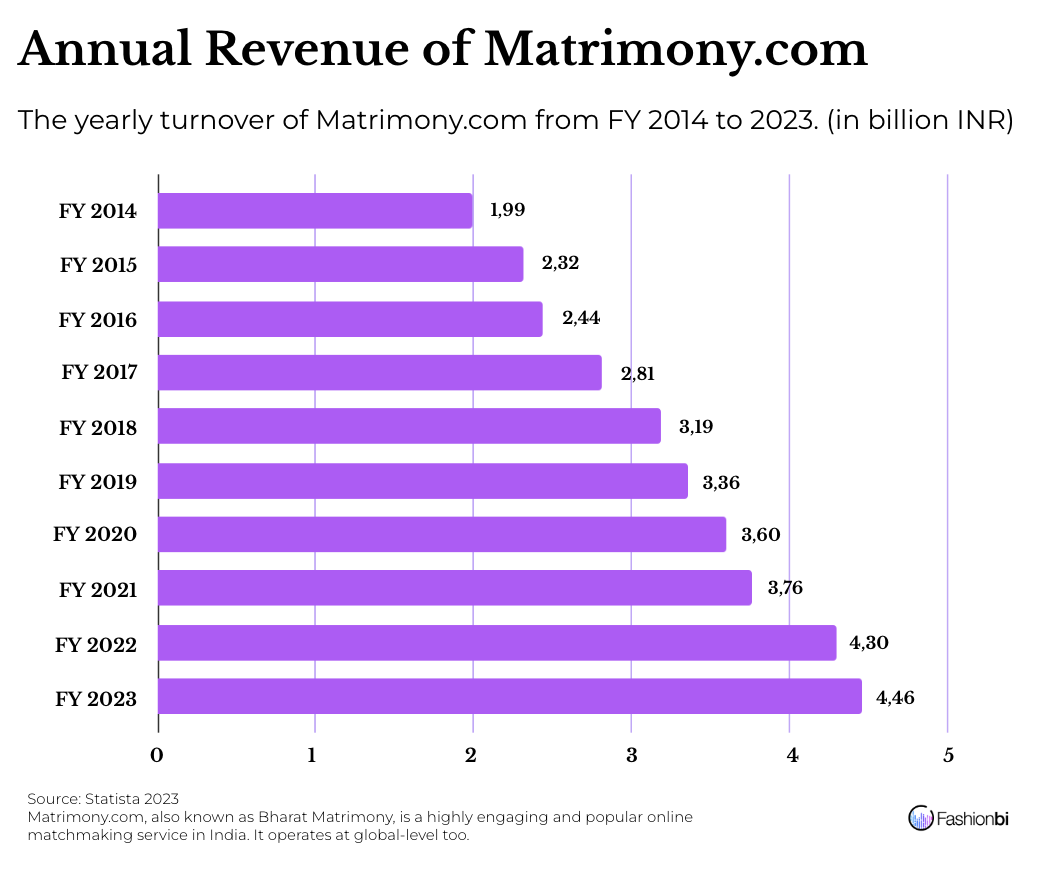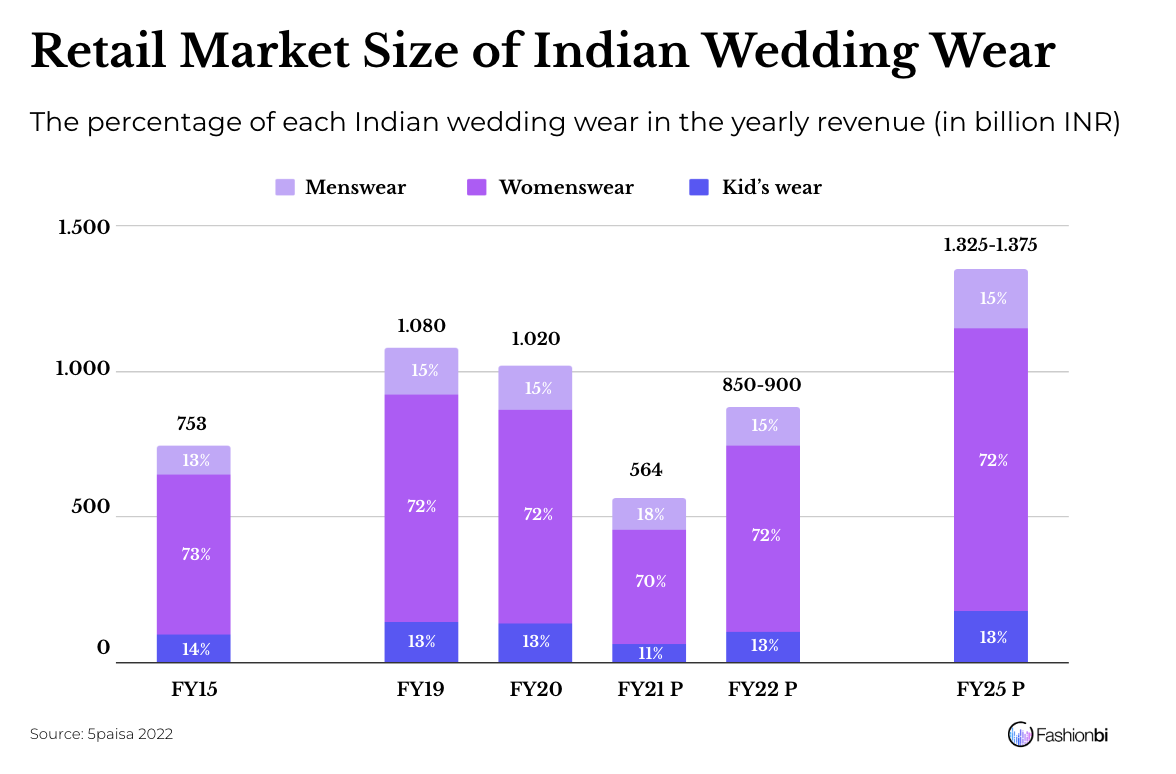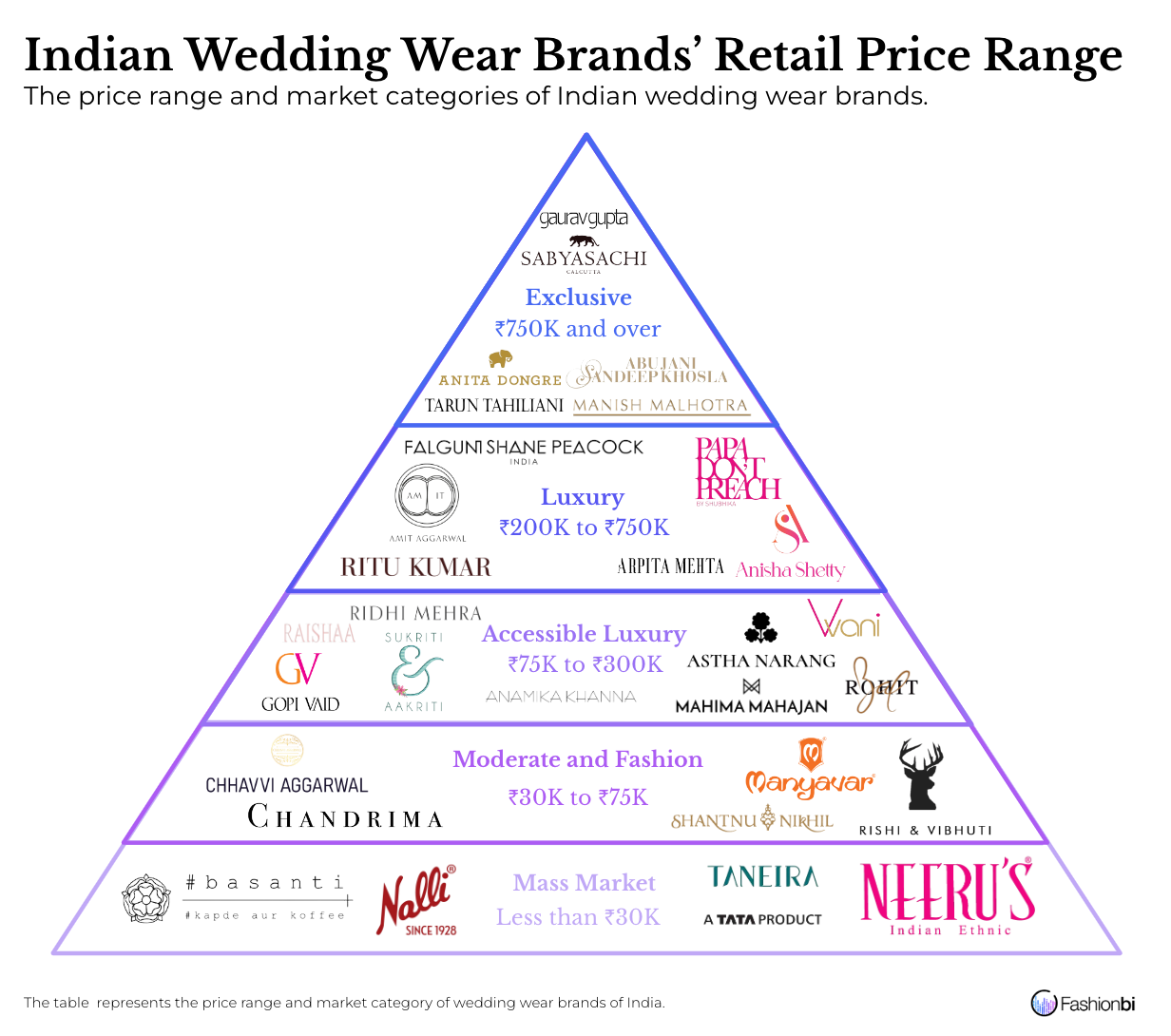India owns over 25% of the global wedding industry. The wedding business is the fourth largest sector in India. Even though an average wedding will be hosted just for a day or two in many cultures, most Indian weddings can last from three to seven days and even more in some cases. With this, the wedding industry became a major sector in the Indian economy, involving decoration, hotels, accommodation, catering, and entertainment as key fields.
According to the Confederation of All India Traders (CAIT), over 3,2 million weddings were held in the period between November 2022 and December 2022 with revenue summing up to $46 million. At the same time in 2021, a total of 2,5 million weddings earned around $36,2 million. Many industrial experts estimate that the wedding industry has grown by over 200% in 2022.
Depending on Indian Population
By the end of 2022, the total population of India accounted for 1,4 billion, with at least 600 million unmarried people. Around 34% of the Indian population are in the age range of 21-39 and almost 10% are between 15 and 20, who will be attested as ready-to-be-married in five years. The legal age to get married for men is 21 and for women is 18. Approximately, more than 100 million people were actively seeking marriage. The number of rich people in India has increased 11 times in the last decade. According to the Knight Frank Wealth Report 2021 report, the High Net-Worth Individual (HNWI) of India was 0,35 million in 2020.
The wedding market is forecasted to have a boost that was never seen before due to half of the population under the age of 29. With that, the size of the industry is expected to grow 25%-30% at an annual rate.

Demand Over Destinations
Destination weddings have always been a dream for eligible bachelors, especially girls, in India. The guests are more involved in these weddings than in the one conducted in one’s hometown. Parveen Chander Kumar, executive vice president of IHCL, a chain of luxury hotels, states that his company faced a boost of over 48% in the first half of 2022 and 25% compared to 2021.
Tehiya Narvel Events recorded almost 75% of their weddings to be destination weddings. The most ideal destinations for their clients were Italy, Switzerland, and France. Another wedding planning company, A New Knot noted 80% of their weddings to be destinations. In 2022, destination weddings will cost a minimum of ₹30-50 million for two days and 200 guests.
Due to higher costs and most of the guests being unable to come to the weddings hosted in dream destinations, the couples chose to be more intimate. According to WeddingWire India, In 2022, over 63.000 couples chose to have only 100 guests. The most preferred local venues are in Rajasthan (especially Udaipur, Jodhpur and Jaipur) and Delhi. Indian clients choose international venues mostly located in Europe (primarily Switzerland), Maldives, Bali, and Sri Lanka.
Online Matrimonial Sites
Indians use specific matrimonial sites to look for an accurate match for the bride/groom. In the last few years, online matrimonial sites have received more traffic. Its services have increased by 130% each year while dating sites have seen a growth of 88%. Online matchmaking sites have accomplished 6% of the total marriages. The turnover of the matchmaking/dating segment is evaluated to be $260 million by 2024.

Wedding Wear
Indian wedding wear is a crucial category in the fashion industry of India. It consists of textile craftsmanship combined with various embellishments such as hand-done embroidery, stonework, hand-dyeing techniques and much more. This, in turn, led it to be the largest and demanded sector in the fashion industry. The revenue of Indian wedding wear is between ₹850-900 billion. It is estimated to grow at a CAGR of 12% - 15% from 2022 to 2025, resulting in the range of ₹1.325-1.375 billion in 2025.

Moreover, the wedding wear market includes brands that differ from one another in many aspects and cater to different price ranges. For instance, brands such as Nalli, Manyavar, Neeru’s, Taneira, Ridhi Mehra, Rishi & Vibhuti, Gopi Vaid Designs, Chavvi Aggarwal, Chandrima, Shantanu & Nikhil and Basant Ke Kapde Aur Koffee will begin from the price placed between ₹1K to ₹9K. Whereas, brands like Anita Dongre, Ritu Kumar, Mahima Mahajan, Raishaa, Sukriti and Aakriti, and Anisha Shetty have set their starting price from ₹10K to ₹20K. Finally, labels such as Sabyasachi, Manish Malhotra, Gaurav Gupta, Amit Aggarwal, Tarun Tahiliani, Arpita Mehta, Rohit Bal, Astha Narang, and Vvani by Vani Vats charge a minimum price ranging from ₹25K to ₹60K. Some brands offer outfits at an affordable price but when it comes to wedding dresses, their prices go up. Those houses are Falguni Shane Peacock, Anamika Khanna, Abu Jani Sandeep Khosla, and Papa Don’t Preach.
Indians are heavily influenced by the wedding outfits worn by Bollywood celebrities. Actress Anushka Sharma’s Sabyasachi lehenga, which was estimated to be worth ₹3 million (about $40K) became a trendsetter. Prices of custom designer lehengas by Manish Malhotra, Tarun Tahiliani, Ritu Kumar, Abu Jani Sandeep Khosla and others can start from ₹1 million going up to ₹10 million depending on the designer and the craftsmanship. Other top designers who are popular for wedding wear include Anita Dongre, Falguni Shane Peacock, Amit Aggarwal, Anamika Khanna, Arpita Mehta, Anisha Shetty, and Papa Don’t Preach offering dresses with the price set between ₹400K to ₹900K.

Love for Expensive Weddings
Tina Tharwani, the co-founder of the Indian wedding planner company Shaadi Squad, ranges their ultra-high-net-worth individuals (UHNWI) weddings to be between $600K and $3 million. The budget of a wedding deviates depending on the destination, type of wedding, and guest count. After the pandemic, many vendors (who were from villages) sought alternative jobs in their own villages or nearer. This resulted in a shortage of low-salary personnel. WeddingWire India claims that around 31% of the vendors increased their bill charges because of the high labour and goods price.
All Indian weddings will bear jewellery as a crucial part. The renowned couturier Manish Malhotra claims that bridal jewellery symbolises status and wealth in India. India’s Gem and Jewellery market garnered a total revenue of $80 billion in 2021. Based on a report by Technopak, it is estimated that womenswear has 85% of the Indian ethnic wear market’s share. It is expected to grow with a Compound Annual Growth Rate of 15-17% from 2022 to 2025. Famous brands and designers hold 15% of the market share. Luxury hotels in India cost a minimum of ₹20K per room for a night. With that, the hotel rooms might cost over $0,6 billion each year.
Customisation In Each Step
Everybody wants a wedding that is unique from others. It is the one, who can afford, can accomplish their dream wedding. Personalisation is a key aspect of luxury wedding planning. Be it the couple’s attire from the particular designer to making Beyoncé perform in the pre-wedding celebration (at Isha Ambani’s wedding), it is a wedding planner’s hands to satisfy their clients’ needs.
Another important factor is the social media platforms which give inspiration to the couple and the wedding planners to brainstorm new ideas. Not only weddings, but social media also offers ideas for one to provide a useful wedding gift. Indians have an authentic culture of offering gifts to their wedding guests. Many clients want their gifts to be environmentally conscious, while others want them to be more extravagant and a symbol to show their status.
With high requests to customise, many vendors have their scopes high across the sectors such as apparel, decor, gift stationeries, catering, and many more.
Sustainability
Over time, many clients have requested their wedding planners to host a wedding that has a minimum carbon footprint without sacrificing their dream. After the pandemic, over 25% of the queries Shaadi Squad received were to install sustainability. The appeal numbers were low before COVID-19.
The A-Cube Project, another famous wedding planner company, is seeking local craftsmen and NGOs to partner with for decor elements. Moreover, the companies are coming up with creative plans to manage the wastes such as food and decor to be scraped carefully to minimise the environmental damage.
Cover Image: Janki & Sachin Wedding, courtesy F5 Photography



